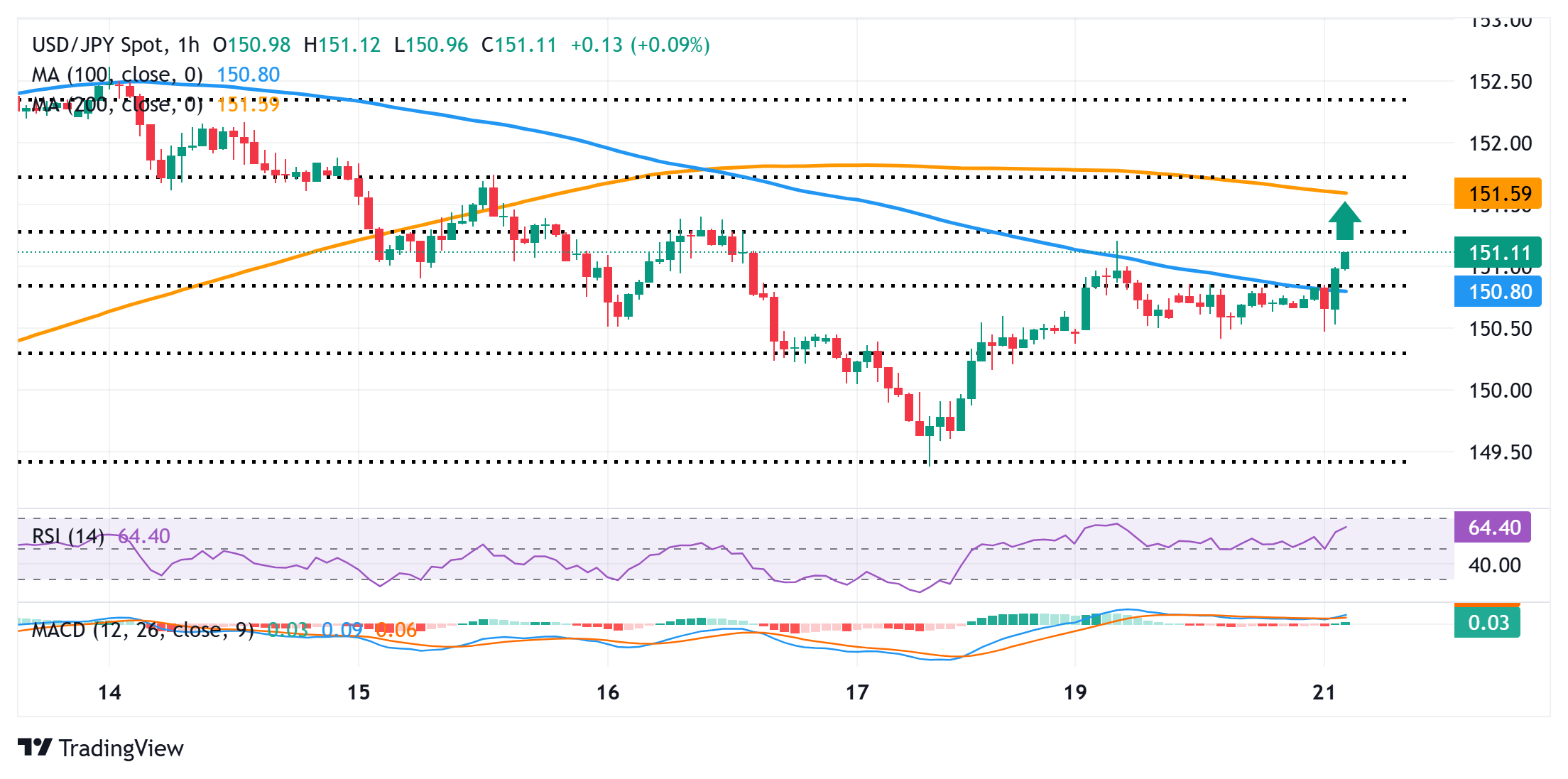Created
: 2025.10.21














![]() 2025.10.21 11:28
2025.10.21 11:28
The Japanese Yen (JPY) turns lower against the US Dollar (USD) for the third straight day on Tuesday, though the downside seems limited ahead of Japan's parliamentary vote on a new Prime Minister. Sanae Takaichi is all but certain to become Japan's first female premier following an alliance with the Japan Innovation Party (JIP), known as Ishin. This fueled speculations about more fiscal stimulus and that the Bank of Japan (BoJ) could delay raising interest rates further, which, in turn, is seen acting as a headwind for the JPY. Moreover, a generally positive tone around the equity markets turns out to be another factor driving flows away from the safe-haven JPY.
Meanwhile, investors seem convinced that the BoJ will stick to its policy normalization path amid sticky inflation and a resilient economy. This marks a significant divergence in comparison to dovish Federal Reserve (Fed) expectations, which fails to assist the USD to build on its modest gains registered over the past two days and could keep a lid on the USD/JPY pair. In fact, traders have fully priced in two more interest rate cuts by the Fed this year and the resultant narrowing of the Japan-US rate differential favors the JPY bulls. However, the uncertainty over the timing of the next BoJ rate hike warrants caution before positioning for any meaningful gains.

The emergence of some dip-buying and a move back above the 151.00 mark favors the USD/JPY bulls. Adding to this, positive oscillators on 1-hour/daily charts back the case for a further appreciating move towards the 151.75 confluence - comprising the 61.8% Fibonacci retracement level of the recent decline from the monthly peak and the 200-hour Simple Moving Average (SMA). A sustained move beyond the latter should allow the USD/JPY pair to surpass the 152.00 mark and climb further towards the next relevant hurdle near the 152.25 supply zone en route to the 153.00 mark.
On the flip side, the 150.50-150.45 region, or the Asian session trough, might continue to act as an immediate support ahead of the 150.25 zone, or the 23.6% Fibo. retracement level and the 150.00 psychological mark. A convincing break below the latter might expose the 149.40-149.35 area, or a nearly two-week low touched on Friday. The USD/JPY pair could extend the fall further towards the 149.00 round figure before eventually dropping to the 148.45-148.40 strong horizontal resistance-turned-support.
The Japanese Yen (JPY) is one of the world's most traded currencies. Its value is broadly determined by the performance of the Japanese economy, but more specifically by the Bank of Japan's policy, the differential between Japanese and US bond yields, or risk sentiment among traders, among other factors.
One of the Bank of Japan's mandates is currency control, so its moves are key for the Yen. The BoJ has directly intervened in currency markets sometimes, generally to lower the value of the Yen, although it refrains from doing it often due to political concerns of its main trading partners. The BoJ ultra-loose monetary policy between 2013 and 2024 caused the Yen to depreciate against its main currency peers due to an increasing policy divergence between the Bank of Japan and other main central banks. More recently, the gradually unwinding of this ultra-loose policy has given some support to the Yen.
Over the last decade, the BoJ's stance of sticking to ultra-loose monetary policy has led to a widening policy divergence with other central banks, particularly with the US Federal Reserve. This supported a widening of the differential between the 10-year US and Japanese bonds, which favored the US Dollar against the Japanese Yen. The BoJ decision in 2024 to gradually abandon the ultra-loose policy, coupled with interest-rate cuts in other major central banks, is narrowing this differential.
The Japanese Yen is often seen as a safe-haven investment. This means that in times of market stress, investors are more likely to put their money in the Japanese currency due to its supposed reliability and stability. Turbulent times are likely to strengthen the Yen's value against other currencies seen as more risky to invest in.
![]()
Created
: 2025.10.21
![]()
Last updated
: 2025.10.21

FXStreet is a forex information website, delivering market analysis and news articles 24/7.
It features a number of articles contributed by well-known analysts, in addition to the ones by its editorial team.
Founded in 2000 by Francesc Riverola, a Spanish economist, it has grown to become a world-renowned information website.
We hope you find this article useful. Any comments or suggestions will be greatly appreciated.
We are also looking for writers with extensive experience in forex and crypto to join us.
please contact us at [email protected].
Disclaimer:
All information and content provided on this website is provided for informational purposes only and is not intended to solicit any investment. Although all efforts are made in order to ensure that the information is correct, no guarantee is provided for the accuracy of any content on this website. Any decision made shall be the responsibility of the investor and Myforex does not take any responsibility whatsoever regarding the use of any information provided herein.
The content provided on this website belongs to Myforex and, where stated, the relevant licensors. All rights are reserved by Myforex and the relevant licensors, and no content of this website, whether in full or in part, shall be copied or displayed elsewhere without the explicit written permission of the relevant copyright holder. If you wish to use any part of the content provided on this website, please ensure that you contact Myforex.
Myforex uses cookies to improve the convenience and functionality of this website. This website may include cookies not only by us but also by third parties (advertisers, log analysts, etc.) for the purpose of tracking the activities of users. Cookie policy